Prediction and Evolution of Carbon Storage of Terrestrial Ecosystems in the Qinling Mountains North Slope Region, China
Abstract
:1. Introduction
2. Materials and Methods
2.1. Overview of the Study Area and Data Sources
2.1.1. Overview of the Study Area
2.1.2. Data Sources
2.2. Research Methodology
2.2.1. Method Overview
2.2.2. Land Use Classification Model and Land Use Transfer Matrix
2.2.3. PLUS Model
2.2.4. InVEST Model
3. Results
3.1. Land Use Structure from 1990 to 2020
3.2. Land Use Transfer Process from 1990 to 2020
3.3. Land Use Structure Simulation under Four Scenarios in 2030
3.4. Change in Carbon Storage
3.4.1. Changes in Carbon Storage from 1990 to 2020
3.4.2. Carbon Storage Simulation in 2030
4. Discussion
4.1. Carbon Storage Analysis for Four Scenarios in 2030
4.2. Main Causes of Carbon Storage Decline
4.3. Suggestions for Increasing Carbon Storage
5. Conclusions
Supplementary Materials
Author Contributions
Funding
Data Availability Statement
Acknowledgments
Conflicts of Interest
References
- Bolan, N.; Hoang, S.A.; Beiyuan, J.; Gupta, S.; Hou, D.; Karakoti, A.; Joseph, S.; Jung, S.; Kim, K.-H.; Kirkham, M. Multifunctional applications of biochar beyond carbon storage. Int. Mater. Rev. 2022, 67, 150–200. [Google Scholar] [CrossRef]
- Kauffman, J.B.; Giovanonni, L.; Kelly, J.; Dunstan, N.; Borde, A.; Diefenderfer, H.; Cornu, C.; Janousek, C.; Apple, J.; Brophy, L. Total ecosystem carbon stocks at the marine-terrestrial interface: Blue carbon of the Pacific Northwest Coast, United States. Glob. Chang. Biol. 2020, 26, 5679–5692. [Google Scholar] [CrossRef] [PubMed]
- Sothe, C.; Gonsamo, A.; Arabian, J.; Kurz, W.A.; Finkelstein, S.A.; Snider, J. Large soil carbon storage in terrestrial ecosystems of Canada. Glob. Biogeochem. Cycles 2022, 36, e2021GB007213. [Google Scholar] [CrossRef]
- Brönnimann, S. Global warming (1970–present). In The Palgrave Handbook of Climate History; Palgrave Macmillan: London, UK, 2018; pp. 321–328. [Google Scholar]
- Chen, J.; Zhang, X.; Wang, K.; Yan, Z.; Zhang, W.; Niu, L.; Zhang, Y. Spatial-Temporal Evolution and Prediction of Carbon Storage in Areas Rich in Ancient Remains: A Case Study of the Zhouyuan Region, China. Land 2023, 12, 1266. [Google Scholar] [CrossRef]
- Fernández-Martínez, M.; Sardans, J.; Chevallier, F.; Ciais, P.; Obersteiner, M.; Vicca, S.; Canadell, J.; Bastos, A.; Friedlingstein, P.; Sitch, S. Global trends in carbon sinks and their relationships with CO2 and temperature. Nat. Clim. Chang. 2019, 9, 73–79. [Google Scholar] [CrossRef]
- Tobler, W.R. Cellular geography. Philos. Geogr. 1979, 20, 379–386. [Google Scholar]
- Verburg, P.H.; Soepboer, W.; Veldkamp, A.; Limpiada, R.; Espaldon, V.; Mastura, S.S. Modeling the spatial dynamics of regional land use: The CLUE-S model. Environ. Manag. 2002, 30, 391–405. [Google Scholar] [CrossRef]
- Liu, X.; Liang, X.; Li, X.; Xu, X.; Ou, J.; Chen, Y.; Li, S.; Wang, S.; Pei, F. A future land use simulation model (FLUS) for simulating multiple land use scenarios by coupling human and natural effects. Landsc. Urban Plan. 2017, 168, 94–116. [Google Scholar] [CrossRef]
- Liang, X.; Guan, Q.; Clarke, K.C.; Liu, S.; Wang, B.; Yao, Y. Understanding the drivers of sustainable land expansion using a patch-generating land use simulation (PLUS) model: A case study in Wuhan, China. Comput. Environ. Urban Syst. 2021, 85, 101569. [Google Scholar] [CrossRef]
- Yang, D.; Liu, W.; Tang, L.; Chen, L.; Li, X.; Xu, X. Estimation of water provision service for monsoon catchments of South China: Applicability of the InVEST model. Landsc. Urban Plan. 2019, 182, 133–143. [Google Scholar] [CrossRef]
- Li, X.; Chen, G.; Liu, X.; Liang, X.; Wang, S.; Chen, Y.; Pei, F.; Xu, X. A new global land-use and land-cover change product at a 1-km resolution for 2010 to 2100 based on human–environment interactions. Ann. Am. Assoc. Geogr. 2017, 107, 1040–1059. [Google Scholar] [CrossRef]
- Babbar, D.; Areendran, G.; Sahana, M.; Sarma, K.; Raj, K.; Sivadas, A. Assessment and prediction of carbon sequestration using Markov chain and InVEST model in Sariska Tiger Reserve, India. J. Clean. Prod. 2021, 278, 123333. [Google Scholar] [CrossRef]
- Piyathilake, I.; Udayakumara, E.; Ranaweera, L.; Gunatilake, S. Modeling predictive assessment of carbon storage using InVEST model in Uva province, Sri Lanka. Model. Earth Syst. Environ. 2022, 8, 2213–2223. [Google Scholar] [CrossRef]
- Nel, L.; Boeni, A.F.; Prohászka, V.J.; Szilágyi, A.; Tormáné Kovács, E.; Pásztor, L.; Centeri, C. InVEST Soil Carbon Stock Modelling of Agricultural Landscapes as an Ecosystem Service Indicator. Sustainability 2022, 14, 9808. [Google Scholar] [CrossRef]
- González-García, A.; Arias, M.; García-Tiscar, S.; Alcorlo, P.; Santos-Martín, F. National blue carbon assessment in Spain using InVEST: Current state and future perspectives. Ecosyst. Serv. 2022, 53, 101397. [Google Scholar] [CrossRef]
- Dampha, N.K. Change detection (1985–2020): Projections on land-use land cover, carbon storage, sequestration, and valuation in Southwestern Gambia. Sustain. Environ. 2021, 7, 1875556. [Google Scholar] [CrossRef]
- Abere, T.; Adgo, E.; Afework, S. Trends of land use/cover change in Kecha-Laguna paired micro watersheds, Northwestern Ethiopia. Cogent Environ. Sci. 2020, 6, 1801219. [Google Scholar] [CrossRef]
- Hernández-Guzmán, R.; Ruiz-Luna, A.; González, C. Assessing and modeling the impact of land use and changes in land cover related to carbon storage in a western basin in Mexico. Remote Sens. Appl. Soc. Environ. 2019, 13, 318–327. [Google Scholar] [CrossRef]
- Guo, B. Study on the evolution, theoretical logic and practical path of China’s green development under the goal of carbon peaking and carbon neutrality. China Price 2023, 8, 12–15+19. [Google Scholar]
- Chen, J.; Niu, L.; Song, J.; Wang, K.; Zhang, Y. Analysis on Landscape Elements of Courtyard Building A of Fengchu in Zhouyuan Site in the Early Western Zhou Dynasty. Landsc. Archit. Acad. J. 2023, 40, 101–110. [Google Scholar]
- Zhou, X.; Lv, H.; Zhu, T.; Luo, L.; Kong, Y. The Implementation Path of Ecological Preservation and Recovery Based on “Watershed, Function, and Geography”: The Northern Qinling Mountains of Xi’an Section. Planners 2023, 39, 127–133. [Google Scholar]
- Committee, E.A.R.A. Shaanxi Province Qinling General Plan for Ecological Environment Protection; Shaanxi Provincial Government: Taiyuan, China, 2020. [Google Scholar]
- Dadashpoor, H.; Azizi, P.; Moghadasi, M. Land use change, urbanization, and change in landscape pattern in a metropolitan area. Sci. Total Environ. 2019, 655, 707–719. [Google Scholar] [CrossRef]
- Chen, J.; Zhang, Y.; Liu, X.; Sun, X. Analysis of spatial-temporal evolution of landscape patterns in ancient large city-sites based on multi-temporal Landsat imagery: A case study of the Zhouyuan site region in China. Eur. J. Remote Sens. 2022, 55, 471–484. [Google Scholar] [CrossRef]
- Luo, S.; Hu, X.; Sun, Y.; Yan, C.; Zhang, X. Multi-scenario land use change and its impact on carbon storage based on coupled Plus-Invest model. Chin. J. Eco-Agric. 2023, 31, 300–314. [Google Scholar] [CrossRef]
- Wang, X. Evolution of Ecosystem Services of Weihe River Basin in ShaanXi Qinling MountainsBased on InVEST Model. Master’s Thesis, Northwest University, Xi’an, China, 2022. [Google Scholar]
- Yang, L.; Zhao, J.; Zhu, J.; Liu, L.; Zhang, P. Spatial—Temporal change and prediction of carbon stock in the ecosystem of Xi’an based on PLUS and InVEST models. Remote Sens. Nat. Resour. 2022, 34, 175–182. [Google Scholar]
- Xu, H.; Qiao, J.L.; Huang, X.F.; Ji, L.L. Survey on the problem of arable land. Economic Daily News, 14 February 2022. Available online: https://xuewen.cnki.net/CCND-JJRB202202140011.html (accessed on 6 July 2023).
- Wu, W.Q.; Zhao, Y.; Tian, H.W.; Chen, Y.P. Spatio-temporal variation characteristics and driving mechanism of habitat quality of Qinling Mountains in recent 40 years. J. Earth Environ. 2023, 4, 1–27. [Google Scholar]
- Liu, W.; Jiang, W.; Tang, Z.; Han, M. A study on the pathway to carbon peak by 2030 in China—A portfolio analysis based on GDP growth rate. Sci. Sin. (Terrae) 2022, 52, 1268–1282. [Google Scholar]
- Li, M.Q.; Chen, S.Q. Synergetic Evolution of Economic Growth and Carbon Neutrality Process of Chinese Cities. Urban Environ. Stud. 2022, 4, 94–110. [Google Scholar]
- Zhang, J.X.; Liu, X.; Wang, C.C.; Song, J.X.; Huang, P.; Shi, Y.; Li, Q. Construction of Water Conservation Capacity Evaluation Index System Based on Spatial Heterogeneity in Qinling Mountains. J. Soil Water Conserv. 2022, 36, 290–297. [Google Scholar]
- Zhao, T.; Bai, H.Y.; Deng, C.H.; Meng, Q.; Guo, S.Z.; Qi, G.Z. Topographic differentiation effect on vegetation cover in the Qinling Mountains from 2000 to 2016. Acta Ecol. Sin. 2019, 39, 4499–4509. [Google Scholar]

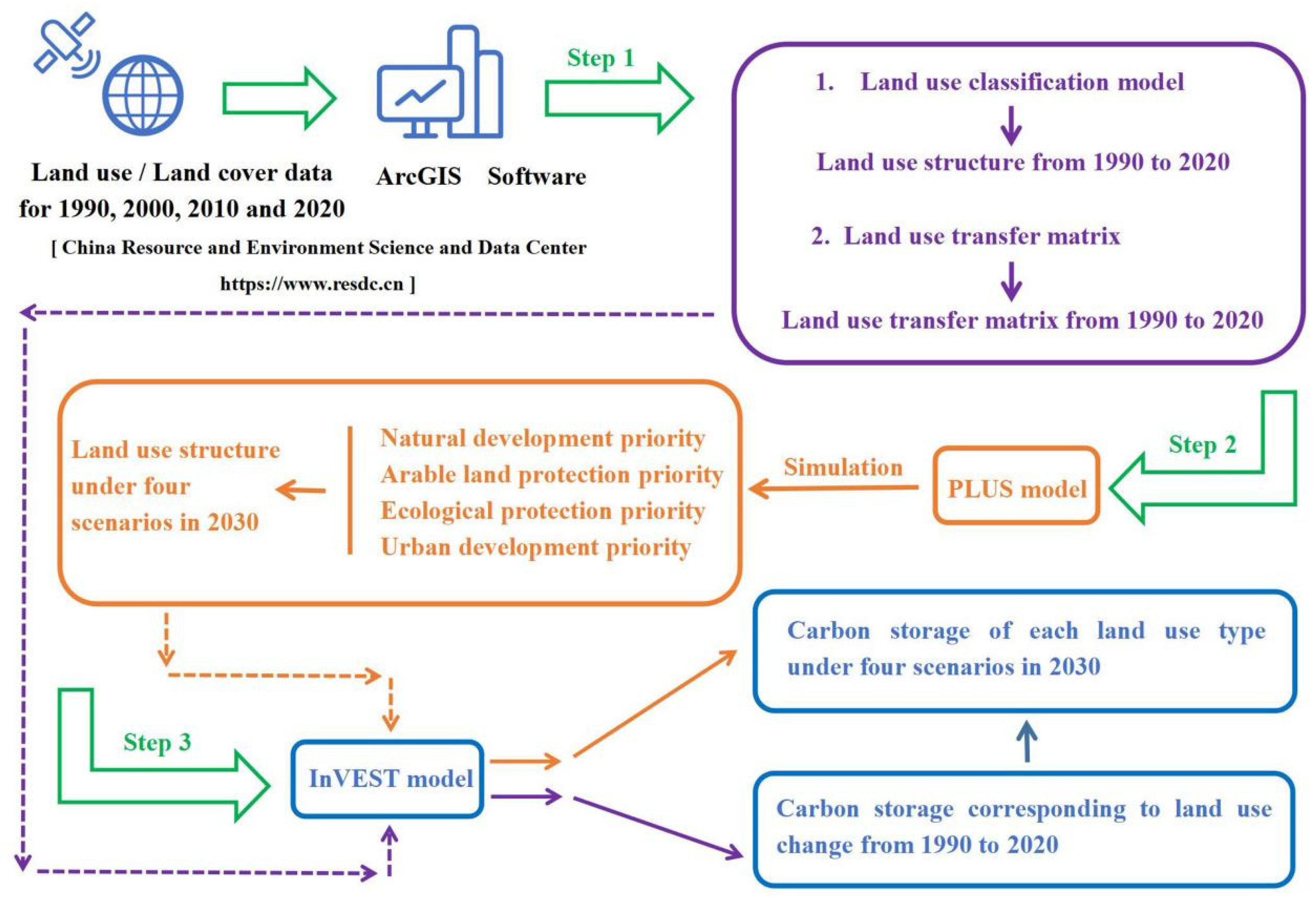

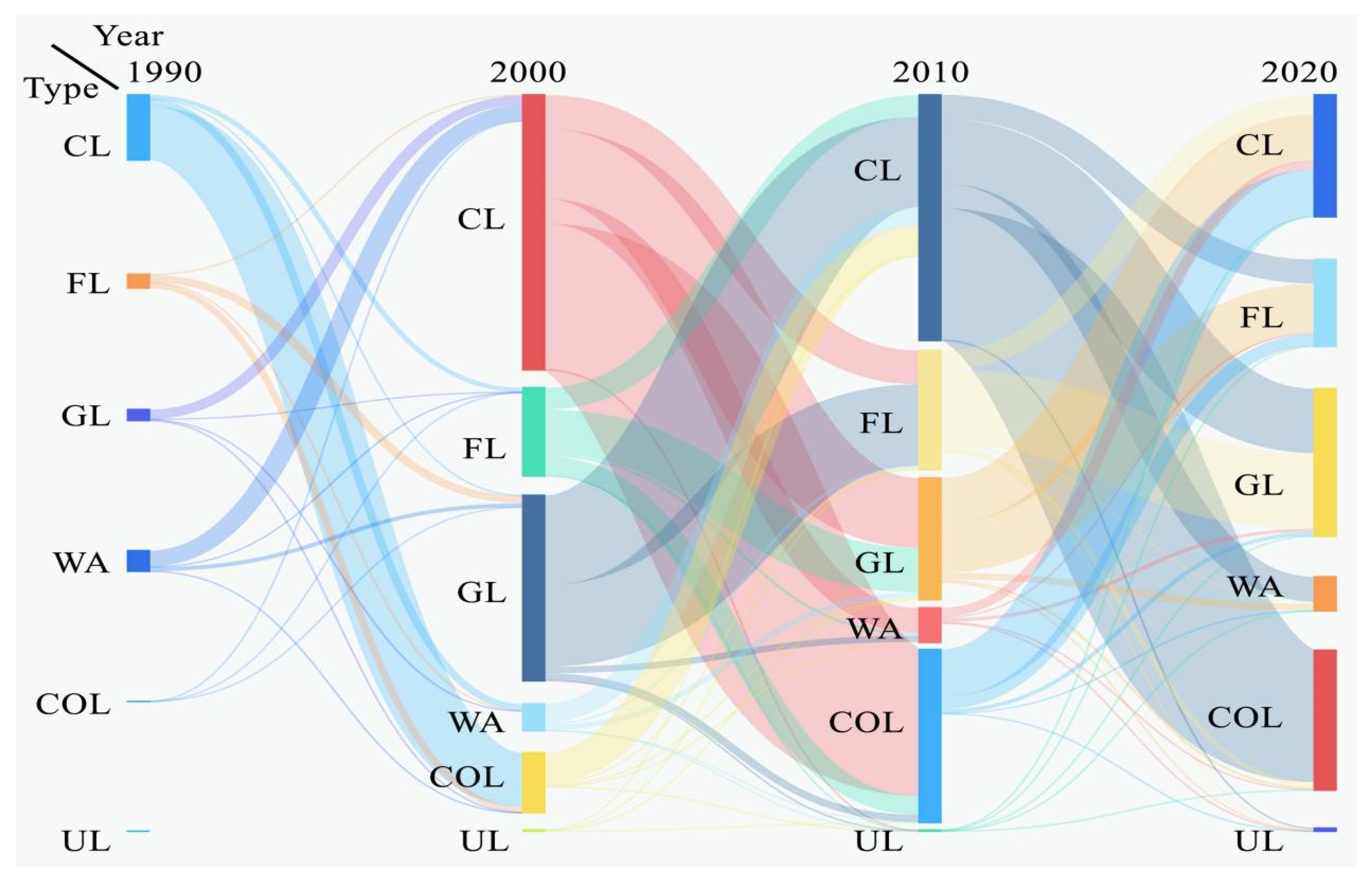

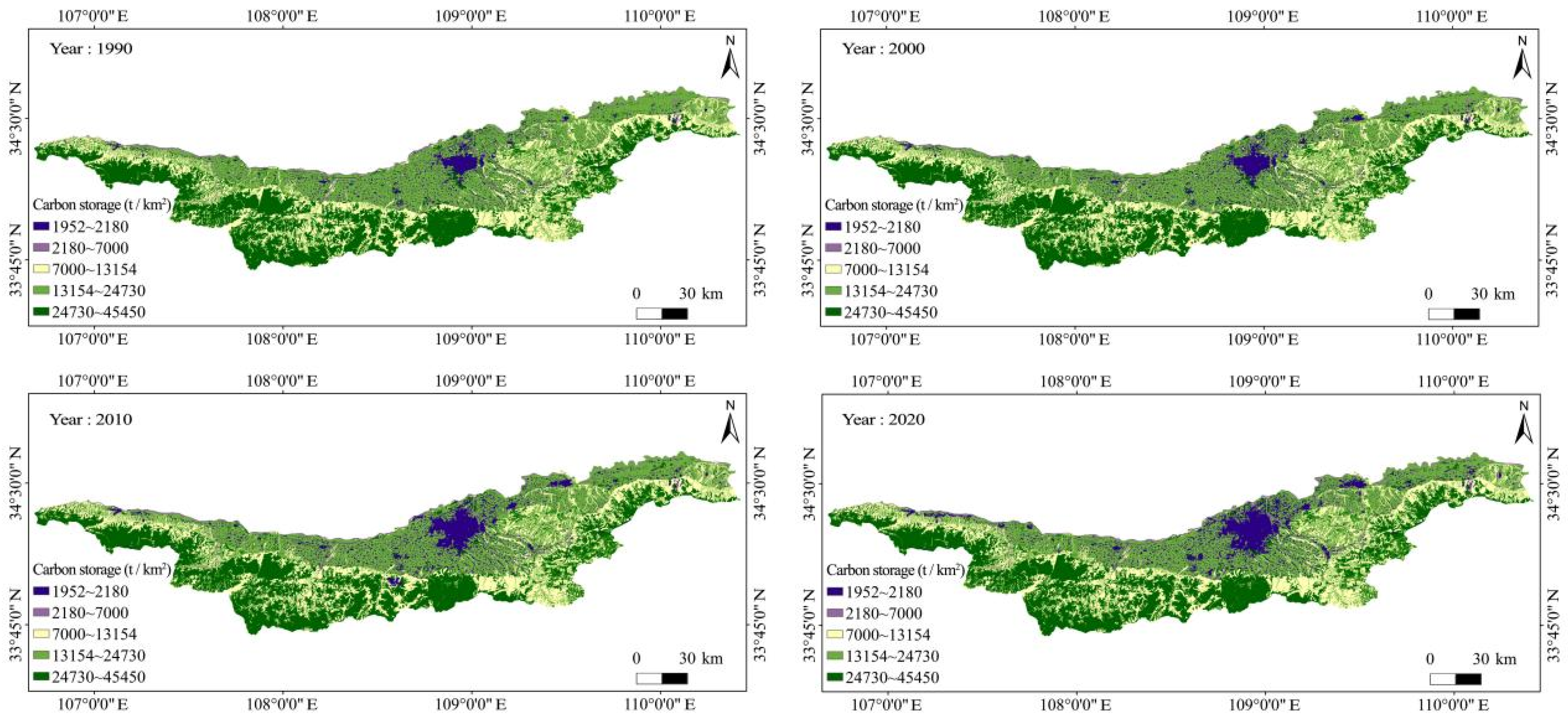
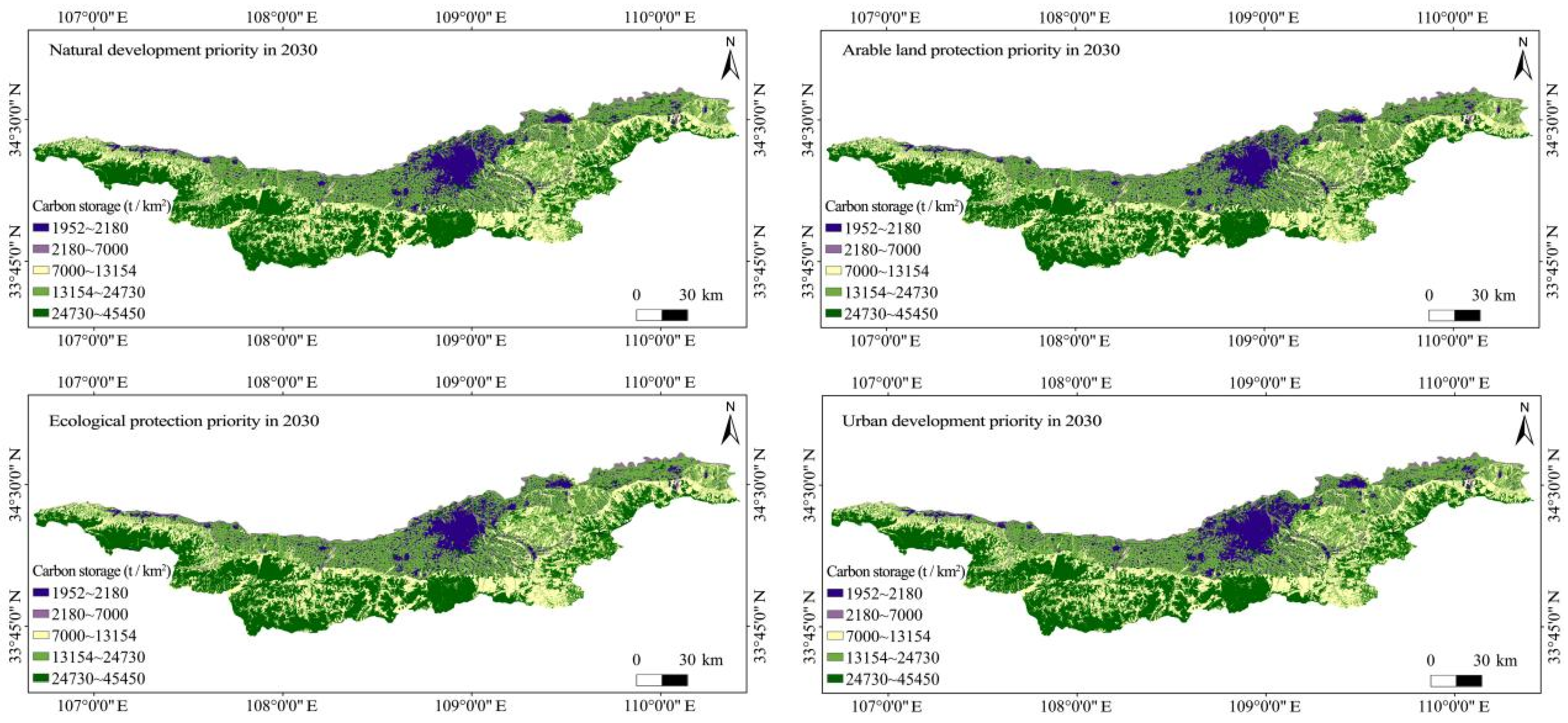
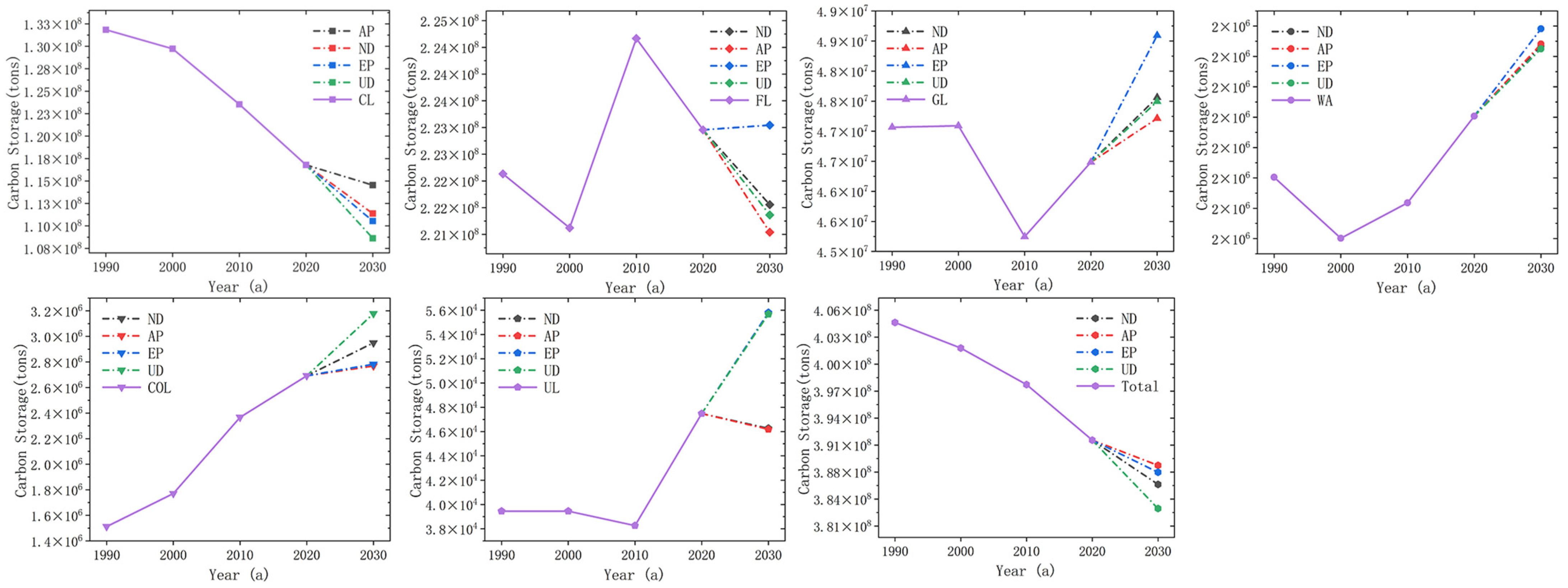
| Category | No. | Data Name | Year | Source |
|---|---|---|---|---|
| Natural Driving Factors | 1 | Land use | 1990, 2000, 2010, 2020 | https://www.resdc.cn (accessed on 14 September 2023) |
| 2 | Annual average temperature | 2020 | http://data.cma.cn (accessed on 14 September 2023) | |
| 3 | Annual precipitation | 2020 | http://data.cma.cn (accessed on 14 September 2023) | |
| 4 | DEM | 2020 | https://www.gscloud.cn (accessed on 14 September 2023) | |
| 5 | Slope | 2020 | Generated by DEM in ArcGIS Software | |
| 6 | Soil type | 2018 | http://soil.geodata.cn (accessed on 14 September 2023) | |
| Social Driving Factors | 1 | Population size | 2019 | https://www.resdc.cn (accessed on 14 September 2023) |
| 2 | GDP density | 2019 | https://www.resdc.cn (accessed on 14 September 2023) | |
| 3 | Nighttime lighting | 2020 | https://www.resdc.cn (accessed on 14 September 2023) | |
| 4 | Distance to main roads | 2020 | Calculations from ArcGIS software | |
| 5 | Distance to railways | 2020 | Calculations from ArcGIS software | |
| 6 | Distance to highways | 2020 | Calculations from ArcGIS software |
| Type | C-above | C-below | C-Soil | C-Dead |
|---|---|---|---|---|
| CL | 46.50 | 80.50 | 107.30 | 13.00 |
| FL | 58.30 | 115.20 | 268.00 | 13.00 |
| GL | 20.59 | 50.46 | 58.28 | 2.22 |
| COL | 3.50 | 5.45 | 10.57 | 0.00 |
| WA | 0.00 | 70.00 | 0.00 | 0.00 |
| UL | 9.20 | 0.10 | 12.50 | 0.00 |
| Year | Area Proportion | CL | FL | GL | COL | WA | UL |
|---|---|---|---|---|---|---|---|
| 1990 | Area/hm2 | 533,134.71 | 489,146.85 | 357,785.10 | 77,482.98 | 27,171.45 | 1809.54 |
| Proportion/% | 35.86 | 32.91 | 24.07 | 5.21 | 1.83 | 0.12 | |
| 2000 | Area/hm2 | 524,574.63 | 487,185.84 | 357,966.54 | 90,689.22 | 24,304.86 | 1809.54 |
| Proportion/% | 35.29 | 32.77 | 24.08 | 6.10 | 1.64 | 0.12 | |
| 2010 | Area/hm2 | 499,535.91 | 494,049.78 | 343,948.68 | 121,269.96 | 25,971.03 | 1755.27 |
| Proportion/% | 33.60 | 33.24 | 23.14 | 8.16 | 1.75 | 0.11 | |
| 2020 | Area/hm2 | 472,269.69 | 490,740.12 | 353,369.79 | 137,921.13 | 30,051.81 | 2178.09 |
| Proportion/% | 31.77 | 33.01 | 23.77 | 9.28 | 2.02 | 0.15 |
| Type | Increase | Decrease | Total Change Data | Exchange Change Data | Net Change Data |
|---|---|---|---|---|---|
| 1990–2000 | |||||
| CL | 5799.60 | 14,359.68 | 20,159.28 | 11,599.20 | 8560.08 |
| FL | 1085.40 | 3046.41 | 4131.81 | 2170.80 | 1961.01 |
| GL | 2597.67 | 2416.23 | 5013.90 | 4832.46 | 181.44 |
| WA | 1664.55 | 4531.14 | 6195.69 | 3329.10 | 2866.59 |
| COL | 13,215.96 | 9.72 | 13,225.68 | 19.44 | 13,206.24 |
| UL | 0.00 | 0.00 | 0.00 | 0.00 | 0.00 |
| Total | 24,363.18 | 24,363.18 | 48,726.36 | 10,975.50 | 13,387.68 |
| 2000–2010 | |||||
| CL | 35,576.01 | 60,614.73 | 96,190.74 | 71,152.02 | 25,038.72 |
| FL | 26,342.82 | 19,478.88 | 45,821.70 | 38,957.76 | 6863.94 |
| GL | 26,870.94 | 40,888.80 | 67,759.74 | 53,741.88 | 14,017.86 |
| WA | 7611.57 | 5945.40 | 13,556.97 | 11,890.80 | 1666.17 |
| COL | 38,128.32 | 7547.58 | 45,675.90 | 15,095.16 | 30,580.74 |
| UL | 268.92 | 323.19 | 592.11 | 537.84 | 54.27 |
| Total | 134,798.58 | 134,798.58 | 269,597.16 | 95,687.73 | 39,110.85 |
| 2010–2020 | |||||
| CL | 26,871.75 | 54,137.97 | 81,009.72 | 53,743.50 | 27,266.22 |
| FL | 19,215.63 | 22,525.29 | 41,740.92 | 38,431.26 | 3309.66 |
| GL | 32,547.42 | 23,126.31 | 55,673.73 | 46,252.62 | 9421.11 |
| WA | 7549.20 | 3468.42 | 11,017.62 | 6936.84 | 4080.78 |
| COL | 30,831.03 | 14,179.86 | 45,010.89 | 28,359.72 | 16,651.17 |
| UL | 694.17 | 271.35 | 965.52 | 542.70 | 422.82 |
| Total | 117,709.20 | 117,709.20 | 235,418.40 | 87,133.32 | 30,575.88 |
| Type | ND | Pro (%) | AP | Pro (%) | EP | Pro (%) | UD | Pro (%) |
|---|---|---|---|---|---|---|---|---|
| CL | 450,402.93 | 30.30 | 463,189.59 | 31.16 | 446,993.64 | 30.07 | 439,229.79 | 29.55 |
| FL | 488,029.05 | 32.83 | 487,029.51 | 32.76 | 490,910.22 | 33.02 | 487,657.26 | 32.81 |
| GL | 361,539.45 | 24.32 | 358,904.52 | 24.14 | 369,385.92 | 24.85 | 361,034.82 | 24.29 |
| WA | 33,347.70 | 2.24 | 33,441.66 | 2.25 | 34,156.89 | 2.30 | 33,214.86 | 2.23 |
| COL | 151,089.30 | 10.17 | 141,846.39 | 9.55 | 142,524.36 | 9.59 | 162,839.97 | 10.95 |
| UL | 2122.20 | 0.14 | 2118.96 | 0.14 | 2559.60 | 0.17 | 2553.93 | 0.17 |
| Type Year | 1990 | 2000 | 2010 | 2020 |
|---|---|---|---|---|
| CL | 131,844,213.78 | 129,727,306.00 | 123,535,230.54 | 116,792,294.34 |
| FL | 222,317,243.33 | 221,425,964.28 | 224,545,625.01 | 223,041,384.54 |
| GL | 47,066,629.91 | 47,090,498.34 | 45,246,448.85 | 46,485,795.87 |
| WA | 1,902,001.50 | 1,701,340.20 | 1,817,972.10 | 2,103,626.70 |
| COL | 1,512,467.77 | 1,770,253.57 | 2,367,189.62 | 2,692,220.46 |
| UL | 39,447.97 | 39,447.97 | 38,264.89 | 47,482.36 |
| Total | 404,682,004.25 | 401,754,810.36 | 397,550,731.01 | 391,162,804.27 |
| Type | ND | AP | EP | UD |
|---|---|---|---|---|
| CL | 111,384,644.60 | 114,546,785.60 | 110,541,527.20 | 108,621,527.10 |
| FL | 221,809,203.20 | 221,354,912.30 | 223,118,695.00 | 221,640,224.70 |
| GL | 47,560,514.65 | 47,213,889.61 | 48,592,717.78 | 47,494,130.57 |
| WA | 2,334,339.00 | 2,340,916.20 | 2,390,982.30 | 2,325,040.20 |
| COL | 2,949,263.14 | 2,768,841.53 | 2,782,075.51 | 3,178,636.21 |
| UL | 46,263.96 | 46,193.33 | 55,799.28 | 55,675.67 |
| Total | 386,084,228.55 | 388,271,538.57 | 387,481,797.07 | 383,315,234.45 |
Disclaimer/Publisher’s Note: The statements, opinions and data contained in all publications are solely those of the individual author(s) and contributor(s) and not of MDPI and/or the editor(s). MDPI and/or the editor(s) disclaim responsibility for any injury to people or property resulting from any ideas, methods, instructions or products referred to in the content. |
© 2023 by the authors. Licensee MDPI, Basel, Switzerland. This article is an open access article distributed under the terms and conditions of the Creative Commons Attribution (CC BY) license (https://creativecommons.org/licenses/by/4.0/).
Share and Cite
Chen, J.; Wang, K.; Li, M.; Wang, X.; Zhang, X.; Niu, L.; Zhang, Y. Prediction and Evolution of Carbon Storage of Terrestrial Ecosystems in the Qinling Mountains North Slope Region, China. Land 2023, 12, 2063. https://doi.org/10.3390/land12112063
Chen J, Wang K, Li M, Wang X, Zhang X, Niu L, Zhang Y. Prediction and Evolution of Carbon Storage of Terrestrial Ecosystems in the Qinling Mountains North Slope Region, China. Land. 2023; 12(11):2063. https://doi.org/10.3390/land12112063
Chicago/Turabian StyleChen, Jian, Kai Wang, Maomao Li, Xianzhi Wang, Xiaoxiao Zhang, Lixin Niu, and Yanlong Zhang. 2023. "Prediction and Evolution of Carbon Storage of Terrestrial Ecosystems in the Qinling Mountains North Slope Region, China" Land 12, no. 11: 2063. https://doi.org/10.3390/land12112063
APA StyleChen, J., Wang, K., Li, M., Wang, X., Zhang, X., Niu, L., & Zhang, Y. (2023). Prediction and Evolution of Carbon Storage of Terrestrial Ecosystems in the Qinling Mountains North Slope Region, China. Land, 12(11), 2063. https://doi.org/10.3390/land12112063







